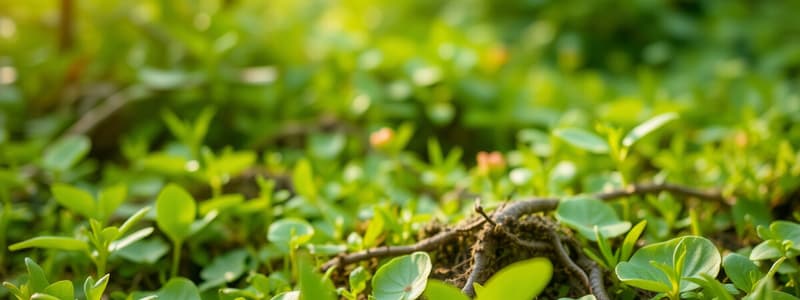Podcast
Questions and Answers
What is a biotic factor?
What is a biotic factor?
- Amount of rainfall
- A measure of water temperature
- Non-living parts of an ecosystem
- Biological influence on organisms within an ecosystem (correct)
What is an abiotic factor?
What is an abiotic factor?
- Non-living parts of an ecosystem (correct)
- Animals hunted for food
- Biological influence on organisms
- Living organisms in an ecosystem
What is humidity?
What is humidity?
Amount of water vapor in the air
What does temperature measure?
What does temperature measure?
What is pH?
What is pH?
What is sunlight?
What is sunlight?
What is rainfall?
What is rainfall?
What is dissolved oxygen?
What is dissolved oxygen?
What does dissolved salt refer to?
What does dissolved salt refer to?
What is turbidity?
What is turbidity?
What is canopy cover?
What is canopy cover?
What is soil?
What is soil?
What is prey?
What is prey?
What is a predator?
What is a predator?
What is a competitor?
What is a competitor?
What is a producer?
What is a producer?
What is a 1st order consumer?
What is a 1st order consumer?
What is a 2nd order consumer?
What is a 2nd order consumer?
What is a decomposer?
What is a decomposer?
What is a population?
What is a population?
Flashcards
Biotic Factors
Biotic Factors
Living organisms and their interactions within an ecosystem.
Abiotic Factors
Abiotic Factors
Non-living components such as soil, climate, and rainfall.
Humidity
Humidity
Concentration of water vapor in the atmosphere.
Temperature
Temperature
Signup and view all the flashcards
pH
pH
Signup and view all the flashcards
Sunlight
Sunlight
Signup and view all the flashcards
Rainfall
Rainfall
Signup and view all the flashcards
Dissolved Oxygen
Dissolved Oxygen
Signup and view all the flashcards
Dissolved Salt
Dissolved Salt
Signup and view all the flashcards
Turbidity
Turbidity
Signup and view all the flashcards
Canopy Cover
Canopy Cover
Signup and view all the flashcards
Soil
Soil
Signup and view all the flashcards
Prey
Prey
Signup and view all the flashcards
Predator
Predator
Signup and view all the flashcards
Competitor
Competitor
Signup and view all the flashcards
Producer
Producer
Signup and view all the flashcards
1st Order Consumer
1st Order Consumer
Signup and view all the flashcards
2nd Order Consumer
2nd Order Consumer
Signup and view all the flashcards
Decomposer
Decomposer
Signup and view all the flashcards
Population
Population
Signup and view all the flashcards
Study Notes
Biotic and Abiotic Factors
- Biotic factors include all living organisms and their interactions within an ecosystem.
- Abiotic factors encompass non-living components such as soil, climate, and rainfall.
Key Definitions
- Humidity: Represents the concentration of water vapor present in the atmosphere.
- Temperature: Refers to the degree of heat measured in an environment, indicating how hot or cold it is.
- pH: Indicates the acidity or basicity level of a substance, important for various biological processes.
- Sunlight: The natural light emitted by the sun, essential for photosynthesis in producers.
- Rainfall: A form of precipitation that contributes to water availability in ecosystems.
- Dissolved Oxygen: A critical water quality indicator that reflects the amount of oxygen available for aquatic organisms.
- Dissolved Salt: Refers to the concentration of salts in water, influencing aquatic life.
- Turbidity: Measures water clarity, indicating the presence of suspended particles.
Ecological Roles
- Canopy Cover: Percentage of ground covered by plant foliage, impacting light penetration and habitat availability.
- Soil: Comprised of mineral particles and organic matter, serving as the foundation for terrestrial plant growth.
- Prey: Organisms caught or hunted by predators for food.
- Predator: The species that hunts and kills other organisms for sustenance.
- Competitor: Organisms that vie for similar resources, affecting population dynamics and ecosystem balance.
- Producer: Organisms, mainly plants, capable of synthesizing their own food through photosynthesis.
Consumer Levels
- 1st Order Consumer: Herbivores that primarily feed on producers.
- 2nd Order Consumer: Carnivores that consume 1st order consumers for energy.
Decomposers and Populations
- Decomposer: Organisms that break down organic waste and dead matter, recycling nutrients back into the ecosystem.
- Population: A collective of individuals of the same species inhabiting a specific area, crucial for studying ecological dynamics.
Studying That Suits You
Use AI to generate personalized quizzes and flashcards to suit your learning preferences.




